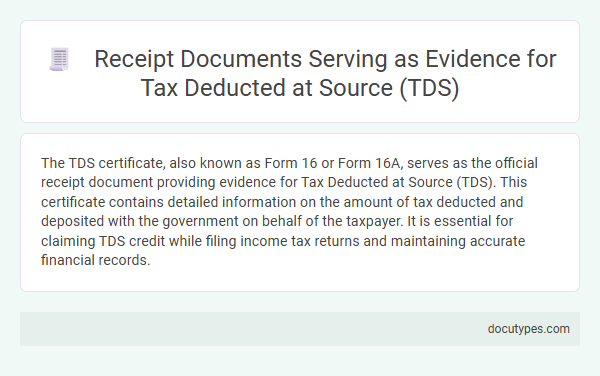The TDS certificate, also known as Form 16 or Form 16A, serves as the official receipt document providing evidence for Tax Deducted at Source (TDS). This certificate contains detailed information on the amount of tax deducted and deposited with the government on behalf of the taxpayer. It is essential for claiming TDS credit while filing income tax returns and maintaining accurate financial records.
Understanding Receipt Documents for TDS
| Receipt Document | Purpose | Key Features | Relevance for Tax Deducted at Source (TDS) |
|---|---|---|---|
| TDS Certificate (Form 16/16A) | Proof of Tax Deducted and Deposited | Issued by the deductor, contains details of deductee, amount deducted, and TDS deposited | Serves as primary evidence for TDS deducted and deposited against the recipient's PAN |
| Challan Receipt | Proof of Tax Payment to Government | Receipt generated after payment of TDS to the government treasury or bank | Confirms the actual deposit of TDS amount, supporting the TDS certificate |
| Form 26AS | Consolidated Tax Credit Statement | Annual statement reflecting all TDS deducted and deposited against PAN | Validates the TDS details from multiple deductors, used for filing income tax returns |
| Payment Voucher | Evidence of Payment for Transactions | Details of amount paid and tax deducted at source shown on the payment document | Supports the accounting and audit trail for TDS deducted during transactions |
Importance of Receipts as TDS Evidence
Which receipt document serves as evidence for Tax Deducted at Source (TDS)? The TDS Certificate, commonly known as Form 16 or Form 16A, serves as the official receipt and proof of tax deducted at source by the deductor. These receipts are crucial for taxpayers to claim credit for the TDS deducted and to avoid double taxation during income tax filings.
Essential Elements of a TDS Receipt
A TDS receipt acts as official evidence confirming the deduction of tax at source by the deductor. It is crucial for both deductors and deductees to validate TDS payments and claims during tax assessments.
- Deductor and Deductee Details - The receipt must clearly mention the names and tax identification numbers of both the deductor and deductee.
- Amount of TDS Deducted - It should specify the exact amount of tax deducted and deposited to the government account.
- Challan or Receipt Number - A unique challan identification number validates the payment and acts as a reference for the taxpayer.
The TDS receipt serves as an indispensable document for tax filing and verifying tax deductions under the Income Tax Act.
Types of Receipts Valid for TDS Claims
The receipt document that serves as evidence for Tax Deducted at Source (TDS) is the TDS certificate issued by the deductor, commonly known as Form 16 or Form 16A. Form 16 is provided to salaried employees, while Form 16A is issued for non-salary payments such as rent, interest, or professional fees. These receipts validate the amount of TDS deducted and deposited with the government, enabling taxpayers to claim credit against their tax liability.
Legal Framework Governing TDS Receipts
The receipt document that serves as evidence for Tax Deducted at Source (TDS) is the TDS certificate, commonly known as Form 16 or Form 16A, issued by the deductor. The legal framework governing these TDS receipts is established under the Income Tax Act, 1961, which mandates the timely issuance of these certificates to the deductee. Your possession of this TDS certificate is crucial for claiming tax credits and ensuring compliance during income tax filings.
Verification Process of TDS Receipt Documents
The receipt document that serves as evidence for Tax Deducted at Source (TDS) is the TDS Certificate, commonly referred to as Form 16 or Form 16A. This certificate verifies the amount of tax deducted and deposited with the government on your behalf.
The verification process of TDS receipt documents involves confirming the details with the Income Tax Department's official records to ensure accuracy.
- TDS Certificate Issuance - Issued by the deductor after depositing TDS, this certificate lists the deducted amount and the deductor's TAN.
- Official Verification - Verification can be done through the Income Tax Department's TRACES portal to confirm the TDS details against official data.
- Assessment Matching - Matching the TDS certificate details with your tax return filing ensures correct tax credits and prevents discrepancies.
Common Mistakes in TDS Receipt Documentation
The TDS Certificate, also known as Form 16 or Form 16A, serves as the official receipt and evidence for Tax Deducted at Source (TDS). This document is issued by the deductor to the deductee, confirming the amount of tax deducted and deposited with the government.
Common mistakes in TDS receipt documentation include incorrect PAN details and mismatched TDS amounts with the actual deduction. Such errors can lead to discrepancies in tax filings and may cause penalties or delays in refund processing.
Retention Guidelines for TDS Receipts
The TDS Certificate serves as the primary receipt document evidencing Tax Deducted at Source (TDS). This certificate is issued by the deductor to the deductee after TDS is deducted and deposited with the government.
Retention of TDS receipts is crucial for compliance and audit purposes. Taxpayers should keep these documents for a minimum of six years from the end of the financial year in which the tax deduction was made.
Challenges in Accepting TDS Receipts as Evidence
Receipts issued as evidence for Tax Deducted at Source (TDS) are crucial for claiming tax credits and validating tax deductions. Challenges arise in accepting these TDS receipts due to discrepancies in document formats, authenticity concerns, and delays in receipt generation.
- Discrepancies in TDS Receipt Formats - Inconsistent formats from different deductors lead to validation issues during tax filing.
- Authenticity Verification Difficulties - Lack of standardized verification processes complicates confirming the genuineness of TDS certificates.
- Delay in Issuance of TDS Certificates - Late receipt of TDS documents affects timely tax credit claims and compliance.
Which Receipt Document Serves as Evidence for Tax Deducted at Source (TDS)? Infographic

